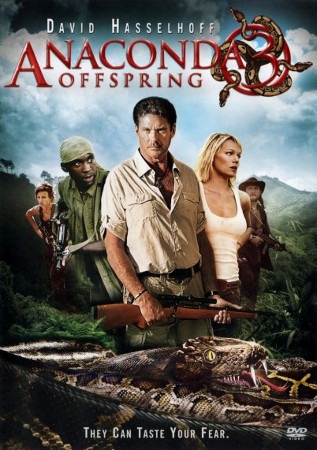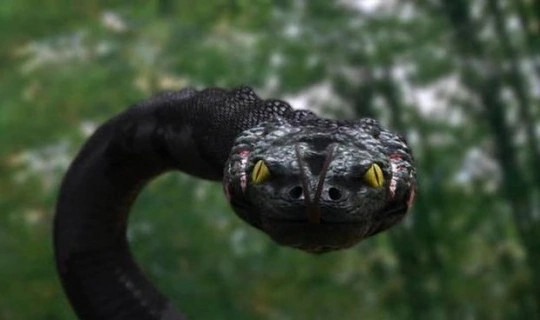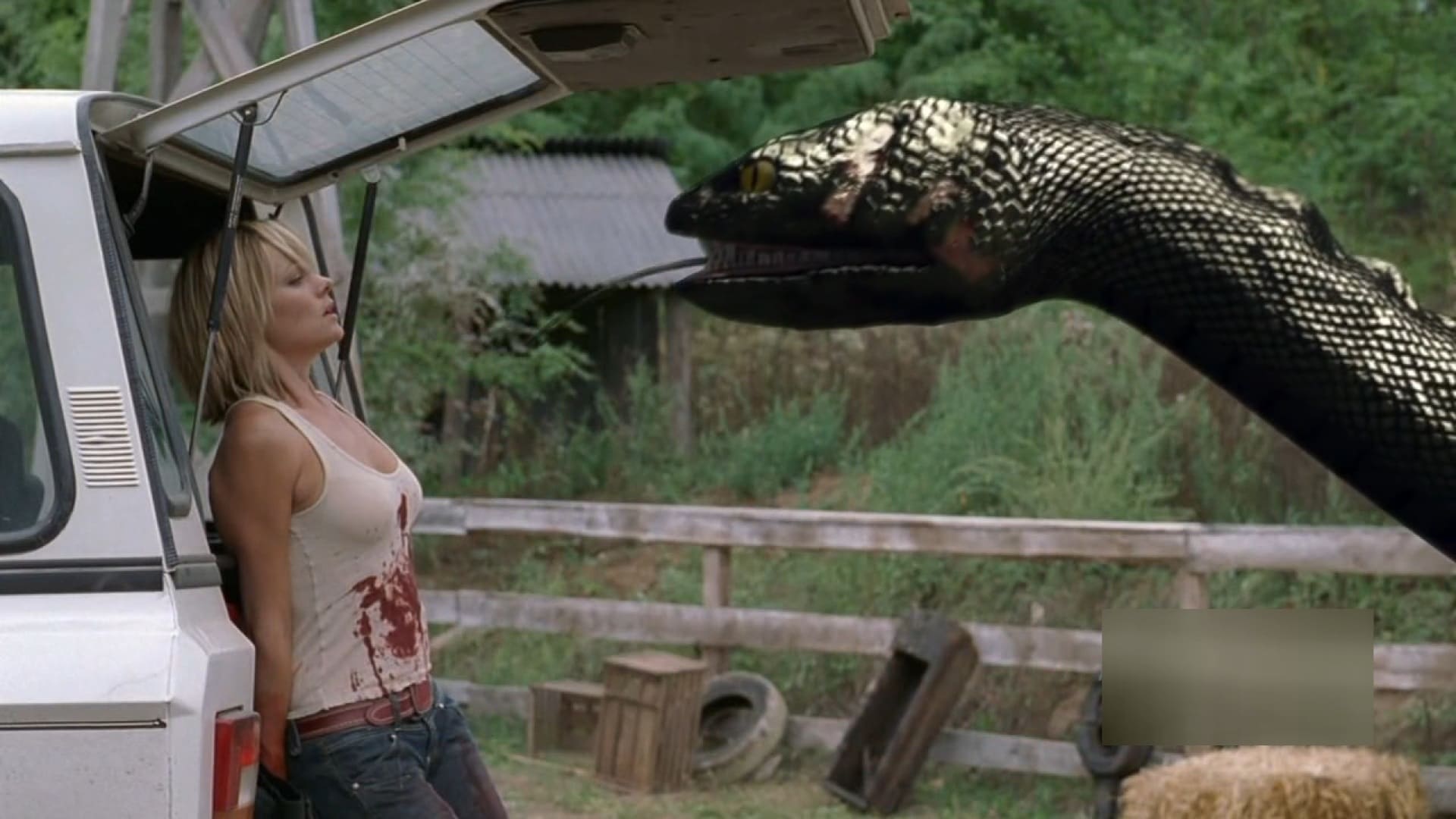
The snake's progress
There is point in the lifecycle of many franchises where they are truly lost, beyond the hope of salvation. In the '80s, it was going direct to VHS; in the '90s and '00s, it was going to direct to cable; in the '10s, it was going direct to streaming. Same thing in different clothes: the point where a movie series has given up on any production values at all, scales down its budget and cast to the point of "looks fine on TV", and gives up even pretending to take itself seriously as anything other than 90s minutes of filler attached to a salable brand name.
2008's Anaconda 3: Offspring finds the Anaconda franchise arriving at that point. It is, damn its eyes, a TV film; it is no less than a film that premiered on Sci Fi, a mark of anti-quality if anything in the 2000s guaranteed a bad genre film was in the offing. It was shot in Romania, for God's sake. I had only scornful things to say about 2004's Anacondas: The Hunt for the Blood Orchid, and I take none of them back, but at least that film understands the appeal of its content. It understands the usefulness of setting up shop in the actual rainforest and letting its gloomy majesty do the necessary work of establishing a mood wherein we look forward to the arrival of giant, murderous snakes.
For that matter, it understands that we're there because, no matter what else, we like the idea of giant, murderous snakes. If there is one sin for which I cannot forgive Offspring, it's that it obviously doesn't give a shit about its titular anacondas. The budget of a Sci Fi original was never going to support even the somewhat whiffy CGI of The Hunt for the Blood Orchid, of course, and Christ knows we weren't going to get the delightful animatronics of the original 1997 Anaconda. But it's hard to regard what we do get as anything other than an act of hostility for the audience. The anacondas in Offspring are weightless and shiny, floating along the ground rather than slithering along it, and this I can at least comprehend. But I cannot comprehend the design of the things. We have well and truly abandoned any pretext of real animals at this point; the 60-foot mutant anacondas of Offspring look like cartoon monsters, with big bug eyes and villainous sneers.

Look, these films have always been trash, and self-aware trash. But this is the point where it becomes "made for Sci fi" trash. The kind that we are invited to view through a veil of sneering superiority, with the filmmakers themselves obviously finding the material too ludicrous and shitty to bother with anything other than smug contempt. It's not a Sharknado-style funny/bad on purpose movie: there's no sense that we're being asked to laugh at the snakes, or anything else. And I suppose I am grateful for this small favor at least, but it does raise the question of what's left about Offspring, if it's not even a parody.
Frankly, I'm not even sure, having watched the whole movie. It's a draining exercise in genre clichés, mostly. Some years after the failed mission of The Hunt for the Blood Orchid, the pharmaceutical company Wexel Hall has busily caught up with where it hoped to be after that film, and then some: not only have they found more blood orchid samples, they've been able to run tests on a number of different species, trying to work out whether it's actually a cures-everything-including-aging wonder drug. And the answer, right now, appears to be, "only if you're an anaconda". To that end, company scientists have, for whatever reason, genetically augmented a breeding pair that they now keep in a research facility in eastern Europe. And God bless the movie for that needless detail: it's smuggled into an opening montage of news reporters speaking against the company's cruel animal testing policies in overcooked dialogue that's trying its damnedest to foreshadow this in a way that we can hopefully find exciting. The point being, if the film cannot disguise it's unrelenting shot-in-Romania-ness, it can at least find some meager excuse for it.
This particular facility is the pet project of a Wexel Hall executive named J.D. Murdoch (John Rhys-Davies), dying of cancer and anxious for his scientists, led by Professor Kane (Serban Celea) and Dr. Amanda Hayes (Crystal Allen), to find a cure for death in time. This does not keep him from being a flailing idiot dumbass, whose first action upon arriving at the facility is to peer into the aquarium and needlessly antagonise the huge female anaconda to the point that she manages to break through the glass, killing Kane with its dagger-like tail. Why would an anaconda, even a mutant anaconda, have a steel-sharp tail it can use to gut people, you might wonder? Simple: because the queen alien in Aliens had one, and Anaconda 3: Offspring is interested in expending no unnecessary effort on creativity.
But honestly, if any part of Offspring works, it's this opening act. The anaconda lab is at least a distinctive-looking location, something that will not be true of any other place we see for the rest of the movie. Also, John Rhys-Davies is here. He's not up to Jon Voight levels of campy excess, but he is having a good time hamming it up as a very angry Evil Capitalist of the purest sort, snarling his lines with force, and emerging as by far the most tangible human presence in the movie. Which takes very little effort: the two actual leads are Allen, a complete non-entity whose entire performance consists of open-mouthed staring, and David Hasselhoff as Murdoch's chosen snake hunter, trying to find the anacondas with his mercenaries while Amanda and her scientists bumble around. And he's just leaning into the fact that he's David Hasselhoff, and therefore has automatic kitsch appeal even if his performance basically just consists of the same leer over and over again.
Once the film goes on the road to find the anacondas, it completely loses any trace of interesting material. Director Don E. FauntLeRoy has no sense at all of pacing, leading to a 91-minute film that feels at least a half-hour longer, with scene upon scene of actors looking concerned and having interchangeable conversations about wherever can those darn anacondas be? The anacondas, for their part, are mostly content to haunt decaying old buildings like slasher movie killers, watching their prey in POV shots that use slightly wider lenses and orange tinting to give us some very inoganic-looking anacondavision. It gives the film a sort of atmosphere, though not the kind the first two movies did, where they were able to make such much out of the muddy rivers that are an anaconda's natural home. Then again, the opening scene has already established that these anacondas are capable of zipping around in the forest canopy, a bit of bad science that I was all set to be pissed at, before I realised just how much more the film was going to have on hand to disappoint me with (speaking of bad science: it also hearkens back to the first film's "anacondas will sometimes just throw their food right back up for sheer evil pleasure" bit, which I admit warmed my heart a little).
I really cannot overstate how extremely fucking dull the middle 45 minutes of Offspring are. The whole film is basically just running out the clock until it fits into the space required by a two-hour TV viewing block with commercials, backloading everything that's remotely enjoyable on the level of giant snakes killing people - with their spike tails, or by hovering in space over them, in a stunningly bad bit of compositing that doesn't look even a little bit like constriction. And when we get a close-up of a snake eating a victim, it's very clear that its body is narrower than an adult human, but so rigidly locked into place that it's not distending as it swallows its prey. And yes, I get it, this movie was made for pocket change, but any dipshit B-movie director in the '50s knew that if your visual effects sucked, you tried to hide them, you didn't put them front and center in close-ups. FauntLeRoy is, apparently not up to the talent of a third-string Roger Corman wannabe.
But I was trying to actually say something nice, which is that the last ten minutes are enough of a hectic race against the snakes, with enough people getting eaten after a long drought of decent death scenes, that you could almost imagine that all of Offspring was the kind of energetic trashy fun that a made-for-cable giant snake movie ought to be. Coupled with the generally fun, stupid opening and the cool visual of the aquarium, and there's a solid 30 minutes of the movie that are at least watchable. You can imagine what that implies about the other 60.
Reviews in this series
Anaconda (Llosa, 1997)
Anacondas: The Hunt for the Blood Orchid (Little, 2004)
Anaconda 3: Offspring (FauntLeRoy, 2008)
Anacondas: Trail of Blood (FauntLeRoy, 2009)
Lake Placid vs. Anaconda (Stone, 2015)
2008's Anaconda 3: Offspring finds the Anaconda franchise arriving at that point. It is, damn its eyes, a TV film; it is no less than a film that premiered on Sci Fi, a mark of anti-quality if anything in the 2000s guaranteed a bad genre film was in the offing. It was shot in Romania, for God's sake. I had only scornful things to say about 2004's Anacondas: The Hunt for the Blood Orchid, and I take none of them back, but at least that film understands the appeal of its content. It understands the usefulness of setting up shop in the actual rainforest and letting its gloomy majesty do the necessary work of establishing a mood wherein we look forward to the arrival of giant, murderous snakes.
For that matter, it understands that we're there because, no matter what else, we like the idea of giant, murderous snakes. If there is one sin for which I cannot forgive Offspring, it's that it obviously doesn't give a shit about its titular anacondas. The budget of a Sci Fi original was never going to support even the somewhat whiffy CGI of The Hunt for the Blood Orchid, of course, and Christ knows we weren't going to get the delightful animatronics of the original 1997 Anaconda. But it's hard to regard what we do get as anything other than an act of hostility for the audience. The anacondas in Offspring are weightless and shiny, floating along the ground rather than slithering along it, and this I can at least comprehend. But I cannot comprehend the design of the things. We have well and truly abandoned any pretext of real animals at this point; the 60-foot mutant anacondas of Offspring look like cartoon monsters, with big bug eyes and villainous sneers.

Look, these films have always been trash, and self-aware trash. But this is the point where it becomes "made for Sci fi" trash. The kind that we are invited to view through a veil of sneering superiority, with the filmmakers themselves obviously finding the material too ludicrous and shitty to bother with anything other than smug contempt. It's not a Sharknado-style funny/bad on purpose movie: there's no sense that we're being asked to laugh at the snakes, or anything else. And I suppose I am grateful for this small favor at least, but it does raise the question of what's left about Offspring, if it's not even a parody.
Frankly, I'm not even sure, having watched the whole movie. It's a draining exercise in genre clichés, mostly. Some years after the failed mission of The Hunt for the Blood Orchid, the pharmaceutical company Wexel Hall has busily caught up with where it hoped to be after that film, and then some: not only have they found more blood orchid samples, they've been able to run tests on a number of different species, trying to work out whether it's actually a cures-everything-including-aging wonder drug. And the answer, right now, appears to be, "only if you're an anaconda". To that end, company scientists have, for whatever reason, genetically augmented a breeding pair that they now keep in a research facility in eastern Europe. And God bless the movie for that needless detail: it's smuggled into an opening montage of news reporters speaking against the company's cruel animal testing policies in overcooked dialogue that's trying its damnedest to foreshadow this in a way that we can hopefully find exciting. The point being, if the film cannot disguise it's unrelenting shot-in-Romania-ness, it can at least find some meager excuse for it.
This particular facility is the pet project of a Wexel Hall executive named J.D. Murdoch (John Rhys-Davies), dying of cancer and anxious for his scientists, led by Professor Kane (Serban Celea) and Dr. Amanda Hayes (Crystal Allen), to find a cure for death in time. This does not keep him from being a flailing idiot dumbass, whose first action upon arriving at the facility is to peer into the aquarium and needlessly antagonise the huge female anaconda to the point that she manages to break through the glass, killing Kane with its dagger-like tail. Why would an anaconda, even a mutant anaconda, have a steel-sharp tail it can use to gut people, you might wonder? Simple: because the queen alien in Aliens had one, and Anaconda 3: Offspring is interested in expending no unnecessary effort on creativity.
But honestly, if any part of Offspring works, it's this opening act. The anaconda lab is at least a distinctive-looking location, something that will not be true of any other place we see for the rest of the movie. Also, John Rhys-Davies is here. He's not up to Jon Voight levels of campy excess, but he is having a good time hamming it up as a very angry Evil Capitalist of the purest sort, snarling his lines with force, and emerging as by far the most tangible human presence in the movie. Which takes very little effort: the two actual leads are Allen, a complete non-entity whose entire performance consists of open-mouthed staring, and David Hasselhoff as Murdoch's chosen snake hunter, trying to find the anacondas with his mercenaries while Amanda and her scientists bumble around. And he's just leaning into the fact that he's David Hasselhoff, and therefore has automatic kitsch appeal even if his performance basically just consists of the same leer over and over again.
Once the film goes on the road to find the anacondas, it completely loses any trace of interesting material. Director Don E. FauntLeRoy has no sense at all of pacing, leading to a 91-minute film that feels at least a half-hour longer, with scene upon scene of actors looking concerned and having interchangeable conversations about wherever can those darn anacondas be? The anacondas, for their part, are mostly content to haunt decaying old buildings like slasher movie killers, watching their prey in POV shots that use slightly wider lenses and orange tinting to give us some very inoganic-looking anacondavision. It gives the film a sort of atmosphere, though not the kind the first two movies did, where they were able to make such much out of the muddy rivers that are an anaconda's natural home. Then again, the opening scene has already established that these anacondas are capable of zipping around in the forest canopy, a bit of bad science that I was all set to be pissed at, before I realised just how much more the film was going to have on hand to disappoint me with (speaking of bad science: it also hearkens back to the first film's "anacondas will sometimes just throw their food right back up for sheer evil pleasure" bit, which I admit warmed my heart a little).
I really cannot overstate how extremely fucking dull the middle 45 minutes of Offspring are. The whole film is basically just running out the clock until it fits into the space required by a two-hour TV viewing block with commercials, backloading everything that's remotely enjoyable on the level of giant snakes killing people - with their spike tails, or by hovering in space over them, in a stunningly bad bit of compositing that doesn't look even a little bit like constriction. And when we get a close-up of a snake eating a victim, it's very clear that its body is narrower than an adult human, but so rigidly locked into place that it's not distending as it swallows its prey. And yes, I get it, this movie was made for pocket change, but any dipshit B-movie director in the '50s knew that if your visual effects sucked, you tried to hide them, you didn't put them front and center in close-ups. FauntLeRoy is, apparently not up to the talent of a third-string Roger Corman wannabe.
But I was trying to actually say something nice, which is that the last ten minutes are enough of a hectic race against the snakes, with enough people getting eaten after a long drought of decent death scenes, that you could almost imagine that all of Offspring was the kind of energetic trashy fun that a made-for-cable giant snake movie ought to be. Coupled with the generally fun, stupid opening and the cool visual of the aquarium, and there's a solid 30 minutes of the movie that are at least watchable. You can imagine what that implies about the other 60.
Reviews in this series
Anaconda (Llosa, 1997)
Anacondas: The Hunt for the Blood Orchid (Little, 2004)
Anaconda 3: Offspring (FauntLeRoy, 2008)
Anacondas: Trail of Blood (FauntLeRoy, 2009)
Lake Placid vs. Anaconda (Stone, 2015)






